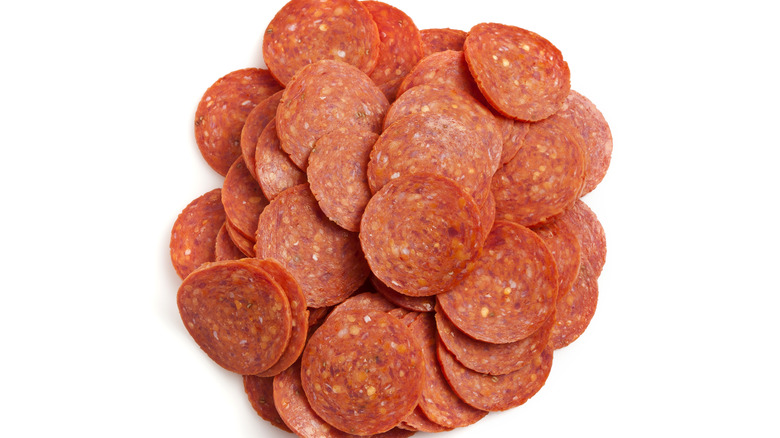Ever Wonder Why Some Pepperoni Isn't Refrigerated?
Many people consider pepperoni one of the essential cured meats. Thanks to its salty and savory flavors, just a few slices of this beef and pork sausage can elevate almost any recipe, from pizza to sandwiches. It's typically easy to find pepperoni in the cool deli aisle of a local grocery store, but it's also accessible in unrefrigerated areas in some aisles, which may be a head-scratcher for some people. The reason for this lies in the way pepperoni is made, which makes it entirely optional to refrigerate prior to opening.
According to the U.S. Department of Agriculture, dry sausages are typically preserved by a combination of fermentation, curing agents, and aging. In the case of pepperoni, this often involves the introduction of a starter culture or citric acid in the meat. The former contains beneficial bacteria that create lactic acid, which hinders the growth of harmful food pathogens and gives this sausage its signature tang.
All of these factors allow pepperoni to sit out on your counter or in the unrefrigerated shelves of grocery stores for days. If kept in a cool, dark place such as the pantry, the cured meat should last up to six weeks before it starts to go bad. This should give you a good chunk of time to incorporate pepperoni it into your pizzas, salads, pastas, and even omelets.
Make pepperoni last longer in the fridge or freezer
If you want your unopened pepperoni to last more than six weeks, transfer it to the fridge. Shelf-stable cured meats last much longer when refrigerated due to the fact that cool temperatures slow down the growth of microbes that cause spoilage. The U.S. Department of Agriculture says that unopened, dry pepperoni should last indefinitely in the fridge, but you'll want to consume it within six months to avoid its fat content from eventually turning sour.
You can also consider moving it to the freezer. Extra cold storage will make your pepperoni last indefinitely, but you'll have an additional eight months to consume it before it starts to lose its savoriness. To prevent freezer burn, wrap the dry sausage in plastic wrap to avoid the frigid air from sucking all the moisture from your food.
To make portioning frozen pepperoni even easier, cut it into separate slices or cubes. But, to keep each piece from sticking to each other, you'll need to either line each piece with parchment paper or chill them on a baking tray before placing them in a resealable bag. Keep each slice moderately thick as well, as this helps pepperoni crisp up into little cups once cooked.
Don't leave your pepperoni in the pantry once opened
While pepperoni stays good in the pantry for over a month, that won't be the case once you've opened it. According to the U.S. Department of Agriculture, dry sausages must be moved to the fridge after they are unsealed. Once you've cut into your pepperoni, its casing will now be opened from one end, which exposes part of the cured meat to the outside air and gives microbes a chance to infiltrate and spoil your food.
You can mitigate this issue by refrigerating any leftovers within two hours, but remember: The shelf-life of pepperoni also becomes dramatically shortened after it gets cut. After opening, this cured sausage only lasts for three weeks in the fridge — approximately half its shelf-life in the pantry.
To ensure your pepperoni does not prematurely go bad in the fridge, place it inside an airtight bag or container. This not only puts them away from any germs lingering on the bottom shelf, but keeps the meat from absorbing any external odors or spills in the refrigerator. If your pepperoni starts to develop a sticky film on its surface or releases a foul odor, throw it out.



